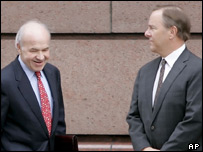
Both Mr Lay and Mr Skilling has always protested their innocence
|
With former Enron heads Ken Lay and Jeffrey Skilling now found guilty of fraud, conspiracy and other charges, the scandal that brought down the former US energy giant in 2001 is back in the headlines.
We look back at the implications of the verdict and how Enron collapsed.
What charges were Lay and Skilling facing?
Jeffrey Skilling, Enron's former chief executive, faced 28 counts of fraud, conspiracy, insider trading and lying to auditors for allegedly trying to fool investors into believing Enron was healthy before the firm crashed.

Former finance boss Andrew Fastow was blamed by the bosses
|
Enron's founder and former chairman Ken Lay had faced six counts of fraud and conspiracy for perpetuating the scheme after Skilling quit in August 2001.
Both had pleaded not guilty, with each blaming junior managers and claiming ignorance of the fraud schemes.
Lay laid the burden of blame at the feet of the company's former finance chief Andrew Fastow, who struck a bargain with prosecutors and agreed to testify against his bosses in return for a lighter prison sentence of 10 years.
Lay died of a heart attack on 5 July, leaving Skilling to face sentencing alone. He could face a very long jail sentence, of 25 years or more.
What happens now?
The judge will be pronouncing the sentence later after further arguments and a pre-sentencing report by the probation service.
This could take two to three months.
This would be the point at which substantial jail sentences could be announced.
But the legal wrangles are not necessarily over.
The two executives will most likely appeal to the US court of appeals, which could take a further 2 years.
The main issue could be the judge's directions to the jury, which pointed out that deliberate ignorance of fraud was no excuse.
This meant the jury could still convict Lay and Skilling even if the two had deliberately not wanted to know what was going on.
How will it affect corporate America?
The Enron case was the biggest in a series of scandals that damaged the reputation of corporate America.
As a direct result the US Congress passed a tough new law, called Sarbanes-Oxley, which imposed stricter rules on auditors and made corporate directors criminally liable for lying about their accounts.
The conviction of Lay and Skilling will be seen as a vindication of the legislation, and make it harder for Republicans in Congress to try and weaken the law, as some companies would like.
It has also moved the balance of power away from company boards towards investors - at least a little bit.
Could it ever happen again?
There is a fierce debate among corporate experts about whether the reforms introduced after Enron have done enough to prevent future fraud.

Thousands were affected when Enron collapsed
|
There is certainly more caution among chief executives about signing off accounts that might be inaccurate now that they face criminal penalties.
But the temptation to boost stock prices has been a consistent feature of booming markets - from the 1920s to the present - especially when the rewards for chief executives can be so high.
In one year, Ken Lay earned $252m including stock options.
As a result, the US has been the pioneer in tougher financial regulation, from the creation of the Securites and Exchange Commission itself in the l930s.
Nevertheless, many argue that it has to be a change in corporate culture, rather than legal restrictions, that are needed to prevent another recurrance of corporate fraud.
What sort of company was Enron?
Enron began life as an energy producer in 1985 following the coming together of two companies - Internorth and Houston Natural Gas.
It moved to become an energy trader, and ended up an energy "bank" providing guaranteed quantities at set prices over the long term.
Enron owned power plants, water companies, gas distributors and other units involved in the delivery of services to consumers and businesses.
But it was the first to realise energy and water could be bought, sold, and hedged just like shares and bonds.
Enron became a huge "market-maker" in the US, acting as the main broker in energy products, also taking financial gambles far bigger than its actual core business.
As a result, in just 15 years it grew from nowhere to become America's seventh largest company, employing 21,000 staff in more than 40 countries.
Fortune magazine named Enron "America's Most Innovative Company" for six consecutive years from 1996 to 2001.
How did it all go wrong?
Its trading operations relied heavily on complicated transactions, many relating to deals many years in the future.
Many of these gambles on the future energy prices were losing money, and to disguise this a network of dubious "partnerships" were created - Enron devices for keeping debts off the balance sheet and thus keeping profits high and shareholders happy.
It is alleged that these partnerships bought losing businesses from Enron to boost its balance sheet.
Some of the partnerships were set up by the company's executives, benefiting them, their families and friends to the tune of millions of dollars.
In addition, many of the company's executives allegedly raked in massive profits by selling their shares before the company's problems went public and its stock price collapsed.
After a while the losses were being shuttled around corners of the empire to keep them hidden, eventually coming to light in 2001.

~RS~q~RS~~RS~z~RS~31~RS~)